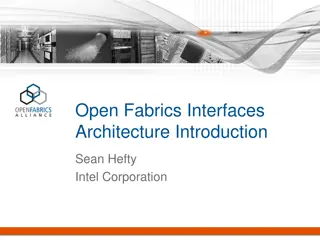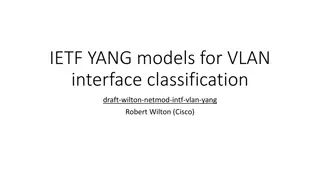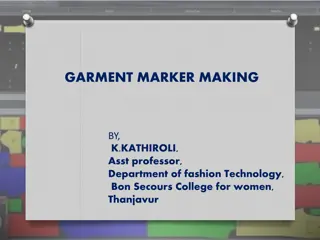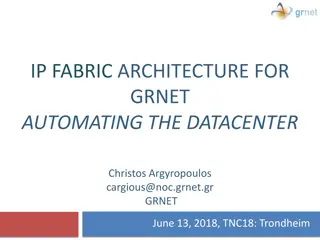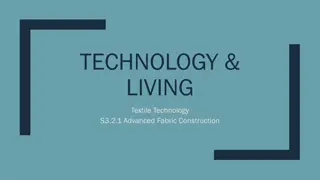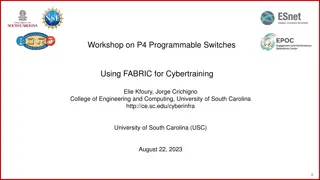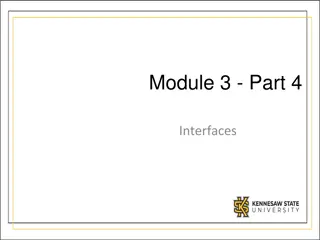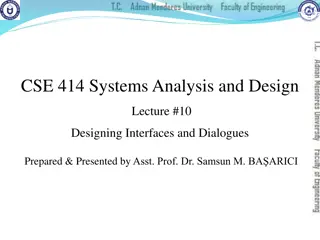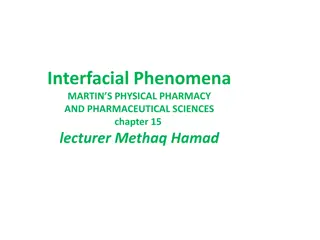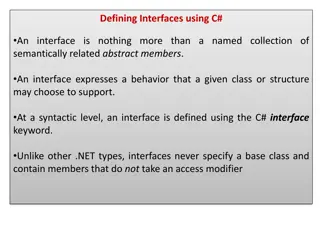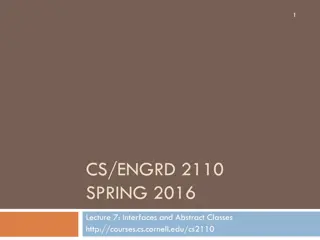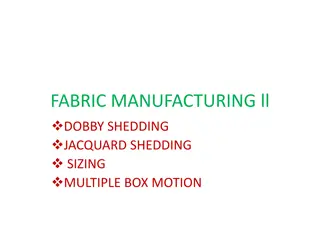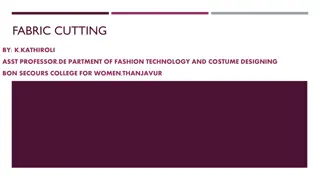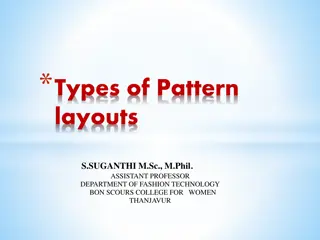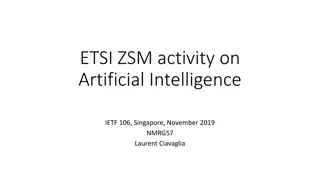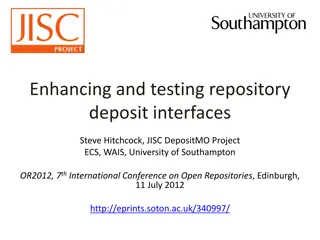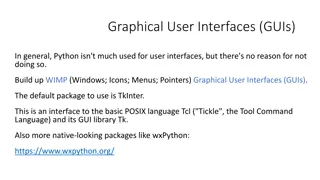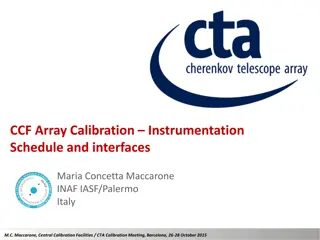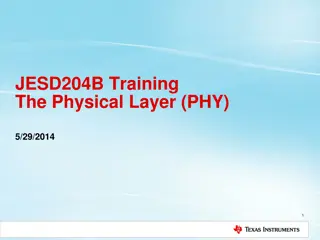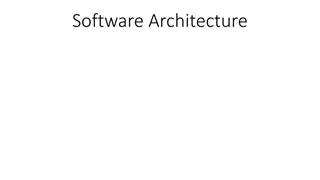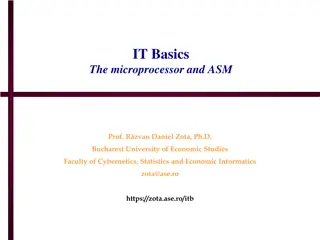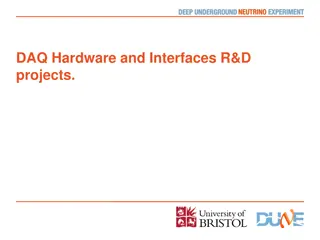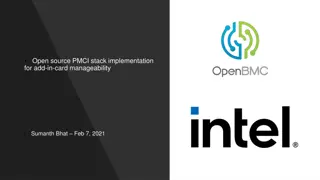Fabric Interfaces Architecture Overview
This detailed content delves into the fabric interfaces architecture presented by Sean Hefty at Intel Corporation. It covers changes in version 2, object models, architectural semantics, conceptual object hierarchy, object relationships, fabric representation, passive fabric endpoint functionalities, and more.
Download Presentation

Please find below an Image/Link to download the presentation.
The content on the website is provided AS IS for your information and personal use only. It may not be sold, licensed, or shared on other websites without obtaining consent from the author. Download presentation by click this link. If you encounter any issues during the download, it is possible that the publisher has removed the file from their server.
E N D
Presentation Transcript
Fabric Interfaces Architecture Sean Hefty - Intel Corporation
Changes v2 Remove interface object Add open interface as base object Add SRQ object Add EQ group object 2 www.openfabrics.org
Overview Object Model Do we have the right type of objects defines? Do we have the correct object relationships? Interface Synopsis High-level description of object operations Is functionality missing? Are interfaces associated with the right object? Architectural Semantics Do the semantics match well with the apps? What semantics are missing? 3 www.openfabrics.org
Object Class Model Objects represent collection of attributes and interfaces I.e. object-oriented programming model Consider architectural model only at this point Objects do not necessarily map directly to hardware or software objects 4 www.openfabrics.org
Conceptual Object Hierarchy Fabric Domain Map Address Vector Index Passive Msg Active Endpoint Shared Receive Queue Datagram Descriptor Fabric RDM Completion CM Object inheritance Event Queue AV EQ Group Domain Counter Memory Region Interfaces 5 www.openfabrics.org
Object Relationships Passive EP EQ CM Map AV Fabric Index Msg Active EP Datagram Shared RQ RDM Domain EQ Group CQ CM EQ AV Object scope Counter Domain MR 6 www.openfabrics.org
Fabric Represents a communication domain or boundary Single IB or RoCE subnet, IP (iWarp) network, Ethernet subnet Multiple local NICs / ports Topology data, network time stamps Determines native addressing Mapped addressing possible GID/LID versus IP Passive EP Fabric EQ Domain 7 www.openfabrics.org
Passive (Fabric) EP Listening endpoint Connection-oriented protocols Wildcard listen across multiple NICs / ports Bind to address to restrict listen Listen may migrate with address Passive EP Fabric EQ Domain 8 www.openfabrics.org
Fabric EQ Associated with passive endpoint(s) Reports connection requests Could be used to report fabric events Passive EP Fabric EQ Domain 9 www.openfabrics.org
Resource Domain Boundary for resource sharing Physical or logical NIC Command queue Container for data transfer resources A provider may define multiple domains for a single NIC Dependent on resource sharing Passive EP Fabric EQ Domain 10 www.openfabrics.org
Domain Address Vectors Maintains list of remote endpoint addresses Map native addressing Index rank -based addressing Resolves higher-level addresses into fabric addresses Native addressing abstracted from user Handles address and route changes AV Active EP EQ Domain EQ Group SRQ Counter MR 11 www.openfabrics.org
Domain Endpoints Data transfer portal Send / receive queues Command queues Ring buffers Multiple types defined Connection-oriented / connectionless Reliable / unreliable Message / stream AV Active EP EQ Domain EQ Group SRQ Counter MR 12 www.openfabrics.org
Domain Event Queues Reports asynchronous events Unexpected errors reported out of band Events separated into EQ domains CM, AV, completions 1 EQ domain per EQ Future support for merged EQ domains AV Active EP EQ Domain EQ Group SRQ Counter MR 13 www.openfabrics.org
EQ Groups Collection of EQs Conceptually shares same wait object Grouping for progress and wait operations AV Active EP EQ Domain EQ Group SRQ Counter MR 14 www.openfabrics.org
Shared Receive Queue Shares buffers among multiple endpoints Not addressable Addressable SRQs are abstracted within the endpoint AV Active EP EQ Domain EQ Group SRQ Counter MR 15 www.openfabrics.org
Domain Counters Provides a count of successful completions of asynchronous operations Conceptual HW counter Count is independent from an actual event reported to the user through an EQ AV Active EP EQ Domain EQ Group SRQ Counter MR 16 www.openfabrics.org
Domain Memory Regions Memory ranges accessible by fabric resources Local and/or remote access Defines permissions for remote access AV Active EP EQ Domain EQ Group SRQ Counter MR 17 www.openfabrics.org
Interface Synopsis Operations associated with identified classes General functionality, versus detailed methods The full set of methods are not defined here Detailed behavior (e.g. blocking) is not defined Identify missing and unneeded functionality Mapping of functionality to objects Use timeboxing to limit scope of interfaces to refine by a target date 18 www.openfabrics.org
Base Class Close Bind Destroy / free object Create an association between two object instances Fencing operation that completes only after previously issued asynchronous operations have completed (~fcntl) set/get low-level object behavior Open provider extended interfaces Sync Control I/F Open 19 www.openfabrics.org
Fabric Domain Endpoint Open a resource domain Create a listening EP for connection-oriented protocols Open an event queue for listening EP or reporting fabric events EQ Open 20 www.openfabrics.org
Resource Domain Obtain domain specific attributes Create an address vector, event or completion counter, event queue, endpoint, shared receive queue, or EQ group Query Open AV, EQ, EP, SRQ, EQ Group MR Ops Register data buffers for access by fabric resources 21 www.openfabrics.org
Address Vector Insert Remove Insert one or more addresses into the vector Remote one or more addresses from the vector Return a stored address Convert an address into a printable string Lookup Straddr 22 www.openfabrics.org
Base EP Enable Cancel Getopt Setopt Enables an active EP for data transfers Cancel a pending asynchronous operation (~getsockopt) get protocol specific EP options (~setsockopt) set protocol specific EP options 23 www.openfabrics.org
Passive EP Getname (~getsockname) return EP address Listen Start listening for connection requests Reject Reject a connection request 24 www.openfabrics.org
Active EP CM Connection establishment ops, usable by connection-oriented and connectionless endpoints 2-sided message queue ops, to send and receive messages 1-sided RDMA read and write ops 2-sided matched message ops, to send and receive messages (conceptual merge of messages and RMA writes) 1-sided atomic ops Triggered Deferred operations initiated on a condition being met MSG RMA Tagged Atomic 25 www.openfabrics.org
Shared Receive Queue Post buffer to receive data Receive 26 www.openfabrics.org
Event Queue Read Retrieve a completion event, and optional source endpoint address data for received data transfers Retrieve event data about an operation that completed with an unexpected error Insert an event into the queue Directs the EQ to signal its wait object when a specified condition is met Converts error data associated with a completion into a printable string Read Err Write Reset Strerror 27 www.openfabrics.org
EQ Group Poll Wait Check EQs for events Wait for an event on the EQ group 28 www.openfabrics.org
Completion Counter Retrieve a counter s value Increment a counter Set / clear a counter s value Wait until a counter reaches a desired threshold Read Add Set Wait 29 www.openfabrics.org
Memory Region Desc (~lkey) Optional local memory descriptor associated with a data buffer (~rkey) Protection key against access from remote data transfers Key 30 www.openfabrics.org
Architectural Semantics Need refining Progress Ordering - completions and data delivery Multi-threading and locking model Buffering Function signatures and semantics Once defined, object and interface semantics cannot change semantic changes require new objects and interfaces 31 www.openfabrics.org
Progress Ability of the underlying implementation to complete processing of an asynchronous request Need to consider ALL asynchronous requests Connections, address resolution, data transfers, event processing, completions, etc. HW/SW mix All(?) current solutions require significant software components 32 www.openfabrics.org
Progress - Proposal Support two progress models Automatic and implicit (name?) Separate operations as belonging to one of two progress domains Data or control Report progress model for each domain 33 www.openfabrics.org
Progress - Proposal Implicit progress Occurs when reading or waiting on EQ(s) Application can use separate EQs for control and data Progress limited to objects associated with selected EQ(s) App can request automatic progress E.g. app wants to wait on native wait object Implies provider allocated threading 34 www.openfabrics.org
Ordering - Completions Outbound Is any ordering guarantee needed? Sync call completion guarantees all selected, previous operations issued on an endpoint have completed Inbound Ordering only guaranteed for message queue posted receives 35 www.openfabrics.org
Ordering Data Delivery Interfaces may imply specific ordering rules E.g. Tagged If a sender sends two messages in succession to the same destination, and both match the same receive, then this operation cannot receive the second message if the first one is still pending. If a receiver posts two receives in succession, and both match the same message, then the second receive operation cannot be satisfied by this message, if the first one is still pending. 36 www.openfabrics.org
Ordering Data Delivery Required ordering specified by application [read | write | send] after [read | write | send] RAR, RAW, WAR, WAW, SAW Ordering may differ based on message size E.g. size MTU Needs more analysis with a formal proposal 37 www.openfabrics.org
Multi-threading and Locking Support both thread safe and lockless models Lockless based on MPI model Single single-threaded app Funneled only 1 thread calls into interfaces Serialized only 1 thread at a time calls into interfaces Are all models needed? Thread safe Multiple multi-threaded app, with no restrictions 38 www.openfabrics.org
Buffering Support both application and network buffering Zero-copy for high-performance Network buffering for ease of use Buffering in local memory or NIC In some case, buffered transfers may be higher- performing (e.g. inline ) Registration option for local NIC access Migration to fabric managed registration Required registration for remote access Specify permissions 39 www.openfabrics.org


